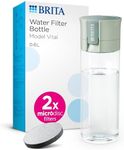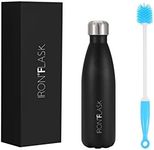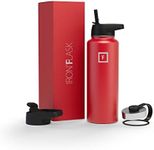Buying Guide for the Best Water Filtration Bottles
When choosing a water filtration bottle, it's important to consider your specific needs and the environments in which you'll be using the bottle. These bottles are designed to filter out impurities and contaminants from water, making it safe to drink. Whether you're hiking, traveling, or just want cleaner water on the go, understanding the key features of these bottles will help you make an informed decision.Filtration TechnologyFiltration technology refers to the method used to remove impurities from the water. This is crucial because it determines what contaminants the bottle can filter out, such as bacteria, viruses, heavy metals, or chemicals. Common technologies include activated carbon, UV light, and hollow fiber membranes. If you're traveling in areas with questionable water quality, a bottle with a more comprehensive filtration system is advisable. For everyday use, a simpler filter might suffice.
Filter LifespanFilter lifespan indicates how long the filter will effectively purify water before needing replacement. This is important for both cost-effectiveness and convenience. Lifespan is usually measured in liters or gallons. If you plan to use the bottle frequently or for long trips, a longer lifespan is beneficial. For occasional use, a shorter lifespan might be acceptable.
Flow RateFlow rate is the speed at which water passes through the filter and into the bottle. This affects how quickly you can get clean water. A higher flow rate means faster access to water, which is important if you're in a hurry or need to hydrate quickly. However, higher flow rates might compromise filtration quality, so balance is key. Consider your patience level and how quickly you need water when choosing.
Bottle CapacityBottle capacity refers to the amount of water the bottle can hold. This is important for determining how often you'll need to refill it. Larger capacities are useful for long hikes or trips where water sources are scarce, while smaller bottles are more portable and easier to carry. Consider your typical usage scenarios to decide on the right capacity for you.
Material and DurabilityThe material and durability of the bottle affect its weight, longevity, and safety. Common materials include plastic, stainless steel, and glass. Plastic is lightweight but may not be as durable, while stainless steel is robust but heavier. Glass offers purity but is fragile. Choose a material that suits your lifestyle and the environments you'll be in. Durability is especially important for outdoor adventures.
Ease of CleaningEase of cleaning is about how simple it is to maintain the bottle and its filter. This is important for hygiene and the longevity of the bottle. Some bottles have removable parts that are dishwasher safe, while others require hand washing. If you prefer low-maintenance products, look for bottles with straightforward cleaning processes. Consider how often you'll be able to clean the bottle when making your choice.

















